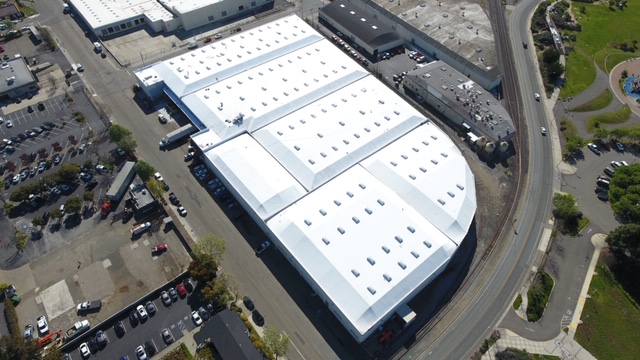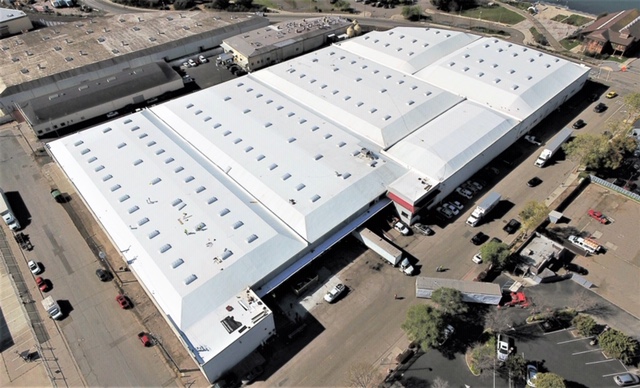What is TPO Roofing?
Since it first came on the market in the early 1990s, Thermoplastic Polyolefin (TPO) roofing has rapidly become one of the most popular materials used in commercial roofing applications today. Indeed, most of us had become so familiar with the signature “white roof” appearance of TPO that we scarcely remember a time when commercial roofs didn’t look like that.


Now the fastest-growing sector of the industry, TPO roofing currently holds about 40 percent of the total commercial roofing market share. Let’s take a deep dive into TPO roofing, looking at what it is and what sets it apart, why it’s so popular, how it’s installed, some of its pros and cons, and what you need to know about maintenance and service life.
What Is TPO Single-Ply Roofing?
TPO roofing is a single-ply thermoplastic membrane synthesized from various rubber types (typically a blend of polypropylene and ethylene-propylene rubber) and reinforced with a fabric scrim to improve its stability, strength, flexibility, and performance. By default, TPO is white in color, but manufacturers have made other colors available in recent years. It is lightweight, relatively easy to install, UV resistant, and is highly valued for its “cool roof” effect, by reflecting the sun’s rays and improving energy efficiency.
How is TPO Different from PVC roofing?
When TPO roofing first came on the market, another thermoplastic membrane system — Polyvinyl Chloride (PVC) — had already been used for some time. TPO was effectively designed to improve PVC by addressing some of its disadvantages, but in practice, as we’ll see, there are a few trade-offs.
The primary difference between TPO and PVC is in the chemical composition — the best way to think of it simply is that TPO is rubber-based, while PVC is effectively vinyl. Both single-ply membrane types are easy to install and good for energy efficiency, but PVC tends to become brittle and crack in cold conditions, while TPO remains more resilient. On the other hand, PVC tends to be more chemical and fire-resistant. It also tends to last longer than TPO.
Pros and Cons of TPO Roofing
Understanding your goals and priorities helps determine whether TPO roofing is right for a particular commercial roofing project. Do the benefits of TPO roofing outweigh the advantages? To help you make an informed decision, let’s look more specifically at TPO’s pros and cons.
Pros of TPO Roofing
- Affordability.TPO roofing is one of the most cost-effective roofing materials on the market, making it ideal for providing quality waterproofing coverage of large surface areas on a budget.
- Ease of installation. Compared to other commercial roof types, TPO roofing can be installed quickly and easily, resulting in lower labor costs and less disruption.
- Energy efficiency. This roofing type is UV resistant and reflects the heat of the sun’s rays for a “cool roof” effect, helping keep building heating and cooling costs in check and resulting in long-term savings over time.
- Lightweight. TPO provides excellent protection without putting undue stress on the building support system.
Cons of TPO Roofing
- Shorter service life. TPO roofing is not as long-lasting as other roofing types and must be replaced more frequently.
- Prone to weathering in warm/hot climates. While designed to keep buildings cool in warm conditions, TPO roofs have been known to deteriorate more quickly in hot climates than in cooler ones, requiring more maintenance and repair.
- Variances in quality. As the “newcomer” to the commercial roofing market, TPO roofing can vary widely in quality, depending on how it is made and who makes it. Only buy TPO roofing from manufacturers with a reliable service record.
- Prone to leaks. Between cracks developing in the laminate surface and weak points in the seams, TPO roofs may develop leaks more often than other types of roofs.
How Is It Installed?
TPO roofing comes in sheets that are easily rolled out and attached to the roof deck. TPO may be fastened to the roof deck by mechanical fastening or with adhesives (either by a separate adhesive application or with self-adhered sheets). The installation process involves clearing and preparing the substrate and then putting down a layer of insulation, typically Polyiso, Expanded Polystyrene (EPS), or Extruded Polystyrene (XPS). The TPO membrane is then rolled out over the insulation and fastened in place. Finally, the seams between the sheets are welded together with heat, typically using a hot-air gun.
Maintenance Needs
TPO roofing is relatively easy to maintain. It may be cleaned periodically using a mild detergent and water along with a low-pressure power washer for rinsing the detergent and removing debris. Use only soft bristled-brushes or brooms to sweep away dirt to avoid damage to the membrane.
While TPO roofs can develop leaks from time to time, they are also relatively easy to repair. Leaks around openings like skylights or pipes can be repaired using a sealant, while tears in the membrane may be repaired with patching and heat welding.
Expected Longevity
The life expectancy of TPO roofing is a matter of debate. Depending on who you ask, TPO roofs may last as long as 22-30 years, while more conservative estimates place the life expectancy between 15-20 years. The longevity you actually get from your TPO roof will depend on various factors, including the manufacturer, climate, and how well the roof is maintained over time.
If you’re considering using TPO roofing for your next commercial roofing project, your best bet is to work with a trusted manufacturer representative to help you make informed decisions on brands and materials. RoofSource represents some of the most reputable roofing brands in the industry, and our trained experts can advise you on the best TPO roofing solutions for maximum performance and longevity. Contact us today to get started.
